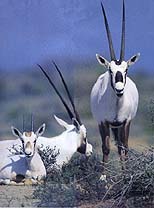by Jacques Flamand
Picture by Mike Hill

The Arabian oryx roams free once again on the vast plains of Saudi Arabia. On March 1st 1990, HRH Prince Sultan Bin Abdulaziz released the first herd of oryx back into the wild.
By all accounts the Arabian oryx was a plentiful antelope which occurred over much of present day Saudi Arabia. However, with the advent of four-wheel drive vehicles and the encroachment of its grazing grounds by man's domestic flocks, even its last stronghold in the Rub al Khali was no safe haven for its survival. Indeed, this species, the largest of the Saudi Arabian antelopes, was last observed there in the late 1970's.
The first step in obtaining oryx for captive breeding was greatly assisted by the far-sighted action of the late King Khalid who, in the late 1970's, established a herd of oryx at his farm at Thumamah. Animals for this herd came from wild caught oryx, and from animals in other private collections in Bahrain, Qatar and the USA. This provided the animals with a broad genetic base and made them ideal for a captive breeding programme.
The establishment in 1986 of the National Wildlife Research Centre (NWRC) near Taif created an ideal location for a carefully managed captive breeding project. In April of that year 57 of the oryx from Thumamah were captured and air-lifted to Taif with assistance of staff from the Zoological Society of London. The oryx soon adapted to their new home but there were serious problems still to be faced.
Three months after the oryx were transported an outbreak of tuberculosis was diagnosed and animals started dying. The Commission was seriously concerned about the situation since the entire herd was now at risk from the disease. There was certainly no possibility of releasing oryx into the wild so long as the tuberculosis was present in the herd.
With painstaking care and patience the NCWCD's veterinary team overcame the threat poised by this highly dangerous disease. It was the first time that this had been successfully managed among captive oryx. Up to that time the usual course of action had been to destroy animals affected with tuberculosis because of the serious health risk to both people and livestock, and also because of the great difficulty involved in treating the disease. However, the great genetic value of the Taif oryx herd seemed to be justification enough to make the extra effort involved in clearing the infection. This was achieved by treating the entire herd for an extended period, and by removing calves from their mothers from the moment of birth. They were then hand-reared, a task that required great skill and dedication. The treatment was successful in producing tuberculosis-free oryx suitable for release into the wild. Indeed, 150 calves have now been hand-reared at the time of writing, and the Taif herd stands at over 178 animals.
The first release area identified for the reintroduction of oryx to the wild was at Mahazat As Said about 150 kms east of Taif. As this area was being severely overgrazed by domestic stock, the 2200 sq. kms area was completely fenced, making it one of the largest enclosed conservation areas in the world. Immediately after the exclusion of camels, goats and sheep the vegetation recovered dramatically. In addition to the outer fence of the Reserve, a pre-release enclosure 250 hectares in size was prepared within the larger protected area so that introduced oryx could undergo a lengthy adaptation period.
Because of the delay brought about by the tuberculosis outbreak at Taif, and in order to speed up the reintroduction programme while also improving the genetic base of the Mahazat As Said oryx, animals from other sources were generously donated to the Commission. Six oryx were sent by the Royal Commission for the Conservation of Nature in Jordan, from their stock at Shaumari, and an additional nine oryx were flown in from the Zoological Society of San Diego in the USA. It was these animals and their calves that formed the first herd of 17 oryx released into the wild on 1st March 1990.
Shortly after their release, rains fell, turning the Mahazat As Said into a paradise for the newly released oryx and ensuring adequate grazing for the remainder of the hot and dry summer that followed. From their first release the oryx have been monitored daily to ascertain how they have adapted to their new environment. On the whole, the condition of the animals has remained consistently good and calves have been born and successfully reared by their mothers. Some males have been killed in combats with other males but these losses must be considered as part of the normal life of wild oryx with competition ensuring that the fittest survive and helping to maintain the herd's overall health. Additional oryx from Qatar, Bahrain and Taif have been introduced to Mahazat As Said since that first historic release, and the number of oryx in the Reserve at the time of writing is one hundred, of which seventy were born there, in the wild.
This first phase in the reintroduction of Arabian oryx to the wild is a great credit to the National Commission for Wildlife Conservation and Development and the NWRC. It is a pleasure to record that new areas have now been designated for similar conservation and the future of Arabian oryx in Saudi Arabia seems assured.
Web Links | Subjects | Search
Arabian Wildlife. Volume 1, Number 1